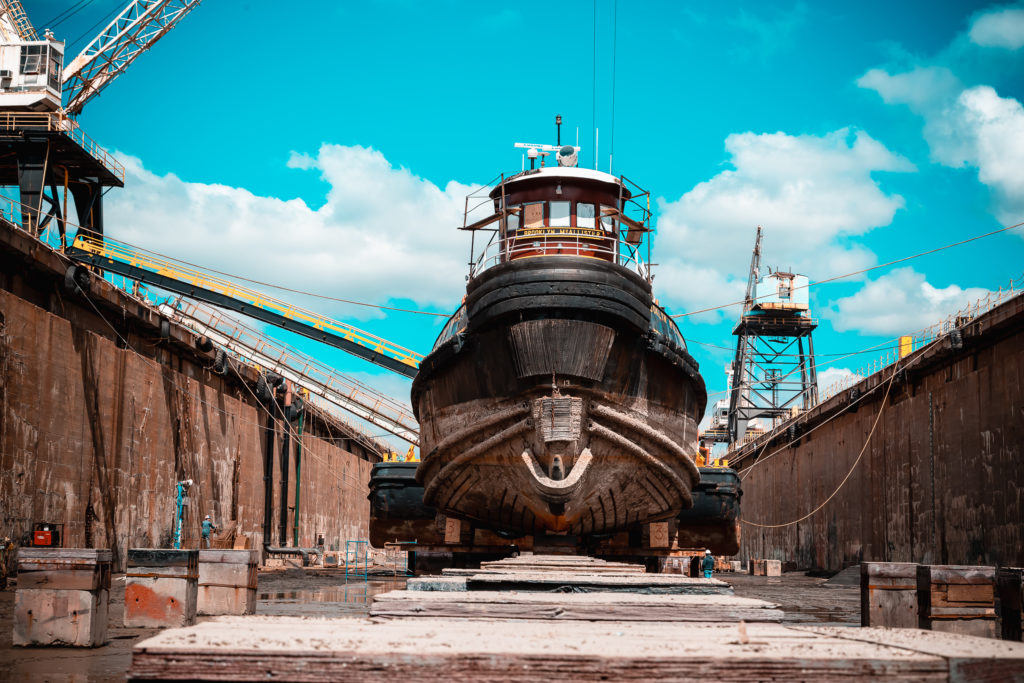The resurgent and expanding Brooklyn Navy Yard has become so heavily associated with innovation that its name can seem like a quaint throwback. When people think of the Navy Yard now, they don’t think shipbuilding. They don’t think heavy industry. They think about tech startups and cutting-edge art projects.
Yet the shipyard that built World War II battleships including the Iowa and the Missouri is still in the business, housing the largest ship-repair facility in New York City, with three dry docks and nine massive cranes capable of lifting up to 200 tons. GMD Shipyard Corp., which leases its site from the city, is a full-service operation, containing specialized shops for every task from carpentry to sandblasting.
GMD is one of only three shipyards in the port area, including Bayonne Dry Dock & Repair in New Jersey and a smaller operation on Staten Island. While business is brisk at GMD, the rapid redevelopment of the city’s waterfront means that urban shipyards will remain rare industrial holdouts.
The shipyard’s general manager, Mike Sanborn (Photo by Patrick Smith)
“We’re a dying breed,” says Mike Sanborn, GMD’s general manager. Sanborn has the tough, weathered look of a man who makes his living outdoors. Clad in workboots, jeans, a neon safety vest and a hard hat that bears his name, Sanborn leads me around the sprawling shipyard, narrating as he goes.
Sanborn talks excitedly about the types of vessels they work on (tugs, ferryboats, barges and training vessels for maritime colleges), the long tenure of many of the workers (“they are like family,” he said) and his love of the industry in which he has worked for three decades.
Sanborn says that GMD has about 150 employees, ranging in skills from general laborers (listed as “shipyard competent personnel” on the company’s website) to skilled tradesmen: electricians, ship fitters, crane operators and welders. The company employs many immigrants from South and Central America, he says. The man who started the business, Carl Gomez, was an immigrant from Spain who worked in shipyards before winning a bid to start GMD in the yard’s then-dormant dry docks. His son Alex now runs the business.
Hundreds of Machines at the Ready
Sanborn moves us around the three dry docks, called “graving docks” in the trade, which are the backbone of GMD’s ability to do work. One contains a large tugboat; another houses the State of Maine, a training vessel owned by the Maine Maritime Academy. A wet berth is currently being used as storage for several ferry boats that move thousands of New Yorkers around each day.
A skilled worker makes repairs in the shipyard’s electrical shop
We head into the machine shop, a massive building that contains hundreds of special-purpose machines that evoke the steampunk aesthetic. Some are clearly in use, while others sit buried underneath heavy covers and dust, as if they hadn’t seen much use in decades. Sparks fly and motors whine as workers weld gigantic pipes used to retrieve fuel from tankers.
The custom jobs the workers need to perform for a wide variety of ships means having all these machines–and the people who know how to run them–ready when necessary. Many of the piecework machines are customized to do one specific type of work and then put back under their covers until the next time they need to be adapted for a particular job.
Running the Shipyard Business
We conclude our tour in Sanborn’s office. GMD has several buildings on the lot, one of which houses the administrative offices, which Sanborn describes as “for the customers.” His office, by choice, is in a large trailer, where he’s closer to the work.
Sanborn estimates that GMD has revenues that range from $30 million to $50 million annually, depending on the company’s volume of contracts for the given year. Each ship-repair job can range from about $500,000 to upwards of several million dollars. The U.S. Coast Guard is one of their larger clients.
The shipyard contains both dry docks and wet berths for housing idle ships
While Sanborn says that business is good for GMD, it’s not a likely growth industry for the New York City area. Costs in the Northeast part of the country run high, particularly for land and the capital cost of the equipment and facilities for this kind of business.
Evolution of the Waterfront
Christopher Clott, the ABS Chair of Marine Transportation and Logistics at SUNY Maritime College in the Bronx, says that the land once devoted to heavy industry now is more valuable for residential and retail purposes. “People want to live on the water. But they don’t want to live next to an industrial park,” Clott said. “Most areas want to maintain a good industrial base and those good-paying, long-standing jobs,” Clott said. “But shipyards are big, noisy and costly.” Clott suggested that technology like data analysis might help ensure the continued success of the existing docks, but it is an industry that “is reluctant to change.”
Outside Sanborn’s office, change is all around. We take a look at Dock 72, the 17-story office building under construction in the backdrop of the decades-year-old cranes that dot the shipyard. The 675,000-sq.-ft.-building, described by its builders as “the next generation waterfront workplace,” will have its own food hall, health-and-wellness center, and open lawn for yard games–all a far cry from the roughneck atmosphere of the shipyard.
Sanborn isn’t sure how much the people who work there will like some of the metallic clamor that naturally emerges from a functioning shipyard, but he is happy to welcome new neighbors. GMD was there before the tech and creative firms got there, and don’t figure to be going anywhere soon.
